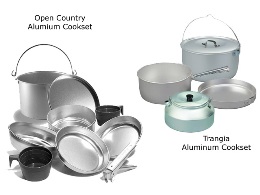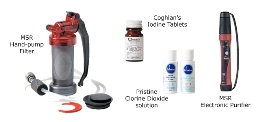| Gear 102 |
Cookware
You can find camping cookware as sophisticated as modern life cookware in your kitchen.
It can be made of stainless steel, aluminum, titanium or Tefal coated non-stick
high-carbon steel. I personally think that all these are just gimmicks.
A pot is a just metal pot afterall.
I will recommend you to focus on its dimensions and ergonomics. Pick a pot
that is deep. So when you stir, stuff will not spill and make everything else messy.
How does the handle bar hold up? Does the pot have a V-notch on the rim for easy pouring?
I simply use the cheapest aluminum pot that I can get. If it burns and chars on the
bottom, I just scrub it with steel wool. Because it is so cheap, you can always replace
it without much worry. Non-stick is only good if you clean it with the right type of cloth.
One scratch will ruin your expensive pot.
Besides, think about how you cook while you are outdoors. There are sand and rocks everywhere;
it is just too easy to get scratches on your pots. Do you want to baby-sit your pots
while you are camping?
|
| |

|
|
|
My picks on cookware.
|
|
Titanium pots are super-lightweight but lack rigidity. My friend once found
his expensive titanium pots deformed because it could not hold its shape inside
his fully loaded backpack. In the end, it is money vs usefulness.
A few of my favourite cookwares:
- Open Country Aluminum uncoated,
- Trangia Aluminum Cookset 25
Water Treatment System
Thanks to the advanced technology in water treatment, we can now choose from among 10
different methods to purify our stream water in the backcountry.
I still remembered carrying iodine solution back in the mid-80s, hand-pumped
filters in mid-90s. Now there are different purifying tablets, gravity filters and
even electronic purifiers that you can bring to the outdoors.
|
|
|
| |
| |

|
|
Typical Filter, Chlorine Dioxide solution,
Iodine Tablets and Electronic Purifier
|
|
There are mainly 4 types of enemies in our backcountry water:
Silt / Debris
This makes the water murky, and less desirable to drink
Protozoa ( > 1 micron)
This includes Cryptosporium and Giardia, the most common protozoa causing diarrhea.
Bacteria (0.3 to 0.5 micron)
This includes camplylobactor.
Viruses (0.05 to 0.3 micron)
This includes common viruses like Hepatitis A or polio.
No doubt the first step is to find cleaner water. Look for running water, or scoop out from
the top of a still pool to avoid debris and other sediments. But what's next?
Boiling is the ultimate way to kill all our enemies in the water. Bring the water to a boil and
keep it boiling for an additional 5 minutes. If you select this purification methold, ensure yourself
to bring enough fuel, but also take into consideration of the wait time for the water to cool
down. You don't want to burn your tongue.
Iodine and Chlorine-based solution or tablets will kill everything except
some Protozoa. They are light and compact, but it will leave an awful taste. Besides, pregnant
or breast-feeding women should not drink iodinated water. Normal people should not drink
iodinated water for longer than 3 consecutive weeks.
Most Filters will do a good job at cleaning the silt and debris out. However, pumping
requires a lot of patience and energy. If available, choose a gravity filter. A Purifier
will incorporate high-quality ceramic filter or chemicals to kill the germs.
I use a gravity filter with a little household bleach. Most of the bad stuff will be
filtered out, and a few drops of bleach will give me the insurance that I need.
|
|